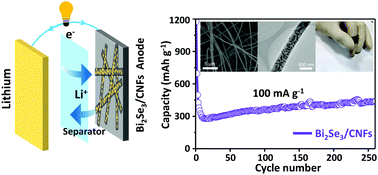Vapor selenization produced Bi2Se3 nanoparticles in carbon fiber 3D network as binder-free anode for flexible lithium-ion batteries†
Abstract
Bi2Se3 is a promising anode material for lithium-ion batteries (LIBs) due to its high capacity and weak van der Waals stacking for Li-ion insertion. However, it suffers from low conductivity and structural instability during the Li-ion insertion and extraction processes. Herein, a new carbon nanofiber (CNF) network decorated with Bi2Se3 nanoparticles (∼40 nm) was facilely prepared and directly used as a binder-free flexible anode in LIBs. The Bi2Se3/CNFs anode delivered a high reversible gravimetric capacity of 443 mA h g−1 after 260 cycles at 100 mA g−1 and a rate capability of 103 mA h g−1 at 16 A g−1. The full cell with LiCoO2 vs. Bi2Se3/CNFs has a discharge specific capacity of 261 mA h g−1 after 100 cycles at 100 mA g−1. The excellent Li-storage performance is attributed to the Bi2Se3 nanoparticles uniformly embedded in the unique conductive 3D CNFs network which effectively improves the conductivity and avoids the layer structure collapse of Bi2Se3 materials. The synergistic effect of the enhanced characteristics successfully improved the long-term cycling and rate capability of the Bi2Se3 anode. This flexible and binder-free Bi2Se3/CNFs electrode has great potential as a neoteric anode material for LIBs.



 Please wait while we load your content...
Please wait while we load your content...